Richard Hackman's 'Five Factor Model'
In 2002, whilst working at Harvard, Richard Hackman developed a research-based model for designing and managing work groups.
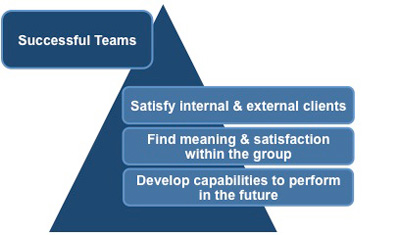 |
His research looked at why some groups were successful and what it was that made them so. He identified three attributes that such groups possessed:
• They satisfy internal and external clients,
• They develop capabilities to perform in the future, and
• The members find meaning and satisfaction within the group.
He then went on to identify the conditions that can increase the chances of success for teams. This he called his 'Five Factor Model.'
Those five factors are:
1. Being a Real Team
2. Compelling Direction
3. Enabling Structure
4. Supportive Context
5. Expert Coaching
These phrases need to be defined so that you can see how in your management role you can influence the success of your team by ensuring these elements exist within the environment of your department.
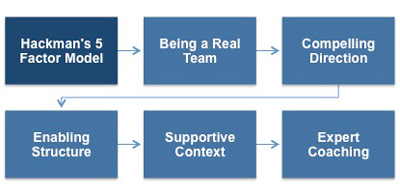 |
Factor 1 - Being a Real Team
What does Hackman mean by 'being a real team'? The elements he said were required to ensure your team is 'a real team' are: the members have a shared task, the team boundaries clearly state who is inside or outside of the group, and the group membership is stable.
As a manager you will have direct control over the first two elements of what constitutes 'a real team', but it is the stability of the group members that is often the hardest aspect to control. If you are based in a project-type environment then it is probable that team stability will last only as long as the project.
If your team includes someone with a rare skill, even this level of stability may not be possible, as different project teams may vie for this scarce resource.
Instability within the team composition can also arise from the nature of the work. For example, managing within a call center environment is often plagued by a high rate of staff turnover due to the nature of the job and the fact that it often attracts transient individuals.
As a manager in this type of environment you will be able to minimize the inevitable disruption of staff turnover by developing an induction program that quickly integrates new recruits into the team.
Factor 2 - Compelling Direction
The second factor of this model is that of providing you team with a compelling direction. This means that you provide your team with clear goals, which are both challenging and consequential.
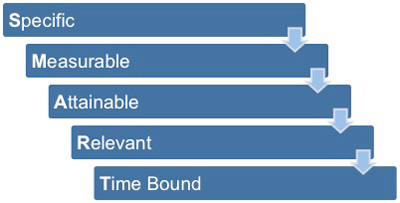 |
As a manager, whatever type of team you are responsible for, you have direct control over the goals you set your team. You can also ensure that you set SMART goals for your staff that motivate and reward them.
These SMART goals need to clearly state how the team contributes to the organization so that the team is aware of their own contribution to the overall mission.
Factor 3 - Enabling Structure
The structure that your team exists in is the third factor that Hackman cites as influential in making your team a success. Some of these aspects you will have control over, while others are going to be dictated by the type of organization you are in and your role within it.
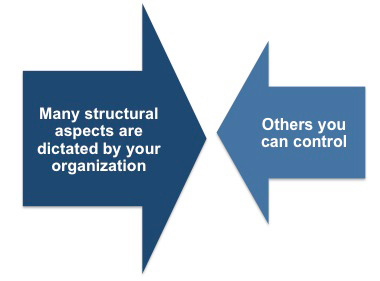 |
Where possible, offering your team variety in the tasks they must complete improves the team's success. Examples might include small changes in task assignment if you are managing a call center team, or keeping the size of your team at a manageable level so that they are not too large and become unwieldy. Sometimes you may want to make small sub-groups within a large team so that the qualities of successful teams can be nurtured.
Within your team's structure you will also want to ensure that some of your key players have good social skills. This makes certain that persuasion and well-presented arguments rather than conflict forms the basis for decision making within the team. These social skills will also ensure that behavior is guided by strong norms.
Factor 4 - Supportive Context
The fourth quality required to ensure successful teams is that of support. A supportive context is essential for companies and organizations, as they are made up of small groups which when combined form a larger group.
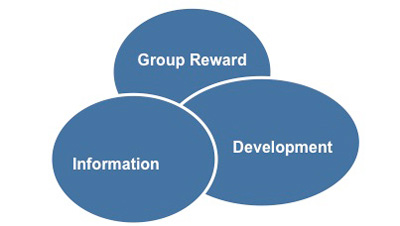 |
This support framework is made up of three elements: reward, development, and information. The reward must be linked to the performance of the group or team. This system must be based upon rewarding the group's performance and cooperation.
The second element of the support must be the development of individual members' skills through an educational system. For many organizations this educational system is formed around the Appraisal System, and as a manager it is vital that you develop your skills in this area.
The third supportive element is connected to the provision of information and guaranteeing easy access to this data and materials. Your ability as a manager to ensure your team have access to the information and materials they need to develop their own skills is crucial.
You can take advantage of the advances in communications technology (computers, noteBook s, eBook readers, and Smartphones , etc.) and the Internet. You will be able to guide your team to the best resources and information they require to develop their skills.
Factor 5 - Expert Coaching
This guidance leads into the finally aspect of the Five Factor Model, that of expert coaching and mentoring. Through the annual appraisal system and your day-to-day management of the team you are able to identify which members of your team require your help with a task, or help that individual develop their interpersonal skills.
Once this need has been identified you coach the person in how they can best meet this challenge and develop the skills they lack. You must be conscious not to be too overbearing in your manner, as this can seriously undermine the effectiveness of the team. The latter is a criticism that Hackman draws attention to in his research and it will significantly reduce the success of any team.
Most teams you encounter in the working world are likely to exhibit a mix of Tuckman's Four Stages and Hackman's Five Factor Model in their day-to-day operations.
As a manager it is useful to be able to identify the stage at which your group is operating and which of the five factors are present in your organization. By understanding the factors that motivate your team in this way you are better able to adapt your leadership style and behaviors to suit your current team.
You will encounter teams that are an almost permanent fixture, but in which individual members may come and go. Your role in this instance is to ensure that any new members are integrated into the pre-existing team as quickly as possible. This enables the team to continue to operate most effectively.
Other teams are more temporary in nature, often set up for a specific project. Frequently this type of team will be made up of individuals who are familiar with and have a great deal of experience of working in teams.
If you are managing this type of team you will facilitate the team to be a cohesive unit as they are likely to be very clear about each other's responsibilities. This means that the forming and storming stages will be more quickly resolved as the whole team is focused on its objective.
As your career progresses you will inherit teams with each new position, and being able to identify at which stage of development this new team is at will help you provide the correct level of support and guidance.
It is inevitable that at some point in your career you will come across a dysfunctional team that is locked into the storming stage and is unwilling to progress no matter what you do. In some instances the only way to handle such a team is to create sub-teams within this group so that each can work effectively and productively.
You can also ensure that the team environment is conducive to the attainment of goals and that sufficient support is available to individuals, with the addition of your coaching expertise as and when required. This Team Development Checklist shows you the behaviors your team requires you to exhibit during its four-stage development.
You may also be interested in:
How to Motivate Your Team | Bruce Tuckman's 'Stages for a Group' Theory | Richard Hackman's 'Five Factor Model'.



